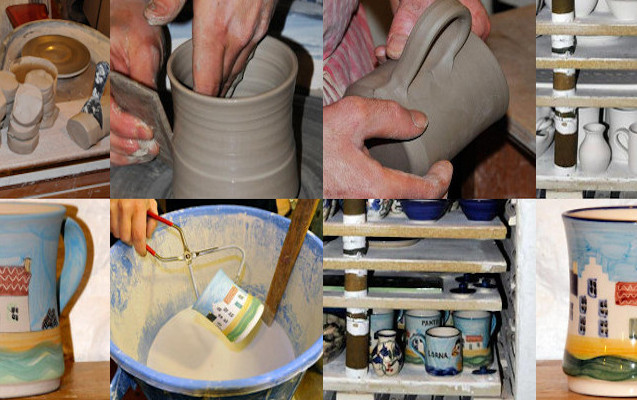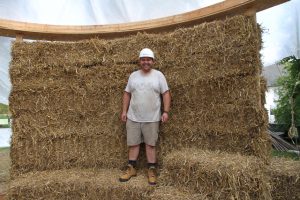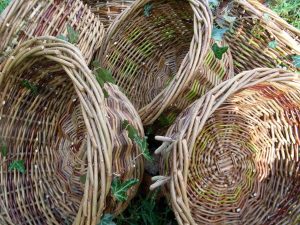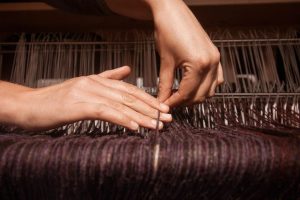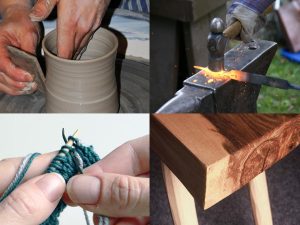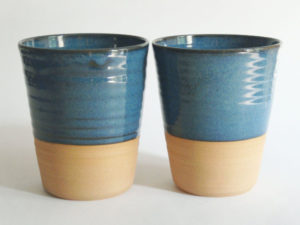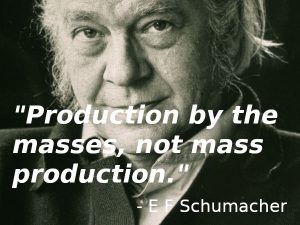At Lowimpact.org we’re interested in helping to bring production back to communities, and so we’re going to be talking with craftspeople, smallholders, natural builders, renewables installers and small business owners in our range of topics. I’ll be asking them about their jobs, and for advice for other people who are interested in doing similar things.
Today I’m talking with Tom, who is a potter. Hello Tom. Could you give us your full name and the name of your business / website.
I’m Tom Humphries. My business is the Little Pot Company. I make wheel-thrown stoneware – mainly useful, everyday items.
I liked your website because you’re producing useful things, rather than just ornamental things. Do you have any handy?
I do – I happen to be drinking my tea out of this (shows stoneware pint tankard). Good for tea or beer. This is what I make – a speckled stoneware. I leave the bare clay at the bottom, and I fire it in a glass kiln that brings out the speckle in the glaze.
What’s the idea behind making it unglazed at the bottom?
Just a bit of added interest. I like the way it looks.
I want to talk about all the things that people need to know if they’re thinking of making a living from making pottery. What were you doing before pottery?
I did a degree in audio technology. I then worked as a technician in theatre, and I worked for live bands. I taught myself web design, and I had an e-commerce website selling musical instruments. That was relevant when it comes to selling pottery. I learnt about how to get things found on the internet – product listings, photos etc. Then I spent 10 years working as a chef. Then I slowly started to make my pottery hobby my job, starting with one day per week, and the rest as a chef. Then when the lockdowns started, I went full-time as a potter.
What made you want to change?
It’s something I love. I couldn’t imagine getting old as a chef. I just love to make pots.
How did you learn how to do it?
My wife was doing it at evening classes, and I decided to buy her a wheel for her 30th birthday. I had a go and I got hooked. I spent a lot of time practicing, read a lot of books and watched a lot of Youtube videos. I never had any formal training. I was terrible to start with, and I didn’t get better very quickly, but I stuck at it, got better, and then managed to sell some things. It grew from there. I’d say now that it’s probably a good idea to have lessons. I’d have learnt more quickly if I’d done that.
Where can people go to find pottery lessons?
It depends what stage you’re at. If you’re a youngster at college, there are places you can do full-time courses. There’s a great one called Clay College in Stoke-on-Trent. But if you have a job, there are lots of colleges that do evening classes, or you might find a local potter who does workshops at the weekend. There are online courses as well – for learning about things like glaze chemistry. Some of those are really good.
What kit do you need and how much does it cost?
It depends what style you’re going to do. I do wheel-thrown stuff, so I need a wheel. I bought the wheel for my wife 10 years ago, and it’s still going strong. That was new, and about £1000 when I bought it, but you can buy them second-hand. My first kiln I got from eBay. It was electric, and cost a couple of hundred pounds. Kilns come in a range of prices. I saw one recently for £12,000. The one I’m using now, I built myself. I welded it all together and added the fire bricks and the gas supply. It lives in the shed. It was quite a project – it took a few years to really think about it and to design and build it. I wouldn’t advise it if you’re just starting out, but it’s possible to do it. You can buy an electric kiln that you can plug into the mains, but if you’re going to use it for more than just a few mugs, you’ll have to get an electrician to install it for you.
How big is your kiln? How many things can you fire in it in one go?
I built mine to fire a week’s work, which is about 40-50 pots. It’s about 8 cubic feet inside (0.25 cubic metres).
And what’s a pot? Could that be a mug or a bowl or a plate?
Yeah. Just any item. I usually have a mixture. But it averages about 40-50 per week.
Where do you get your materials?
I get most of it from a local place in Doncaster. The thing about pottery materials is that they’re quite heavy – clay comes in 12.5 kilo bags usually. If you’re getting those delivered from a website, the delivery is going to be expensive. When I was doing it as a hobby, I’d drive to the local place and pick it up. Now I get a tonne delivered on a lorry to my house.
Ah, so you can get a tonne delivered?
Yes. It takes a long time to get through a tonne, so it’s really for full-time potters. If you’re doing it as a hobby, you’re probably better off driving to your nearest place. There aren’t that many pottery suppliers. I’m lucky that I have one half an hour away. If you don’t have one near you I guess you’d have to plan ahead more or be prepared to pay more postage.
My next questions was going to be whether you need any specific qualifications, but obviously you don’t, as you were self-taught.
You don’t, but knowing what I know now, if I was 16, I’d do an apprenticeship, or do a Clay College course. I think learning from another potter is a great idea. I have family and commitments that mean I can’t do that now. It depends on your situation, but if you have the opportunity to learn from other people, that’s a great idea. I think there’s a distinction between ceramics degrees and a Clay College course. The degree courses tend to be about design, and aren’t so hands-on. I don’t think universities run hands-on courses, which is why Clay College was set up.
So are there potters around the country looking for apprentices?
I think there might be but I’m unaware of any listings. I think it’s more about finding a local potter and approaching them.
Is there any support available (maybe from an association or umbrella organisation) or grants you can get from anywhere?
I’ve just joined the Northern Potters Association, and there are a few other associations. They can help you get some discount on your pottery supplies. I’m not sure about grants – I’ve never really looked into it. I was in the position of being able to just do it myself.
So associations are useful?
As well as discounts, they put on craft fairs, and members share their knowledge etc. I’ve only just joined because I guess I’ve had a hard time accepting myself as a full-time potter – I think I’ve had a bit of impostor syndrome.
Well I’ve looked at your website, and your stuff looks great!
I’ve been profitable for a year now, so I guess I must be OK.
That was my next questions – are you making a living from it?
Yes I am. I’m not rich, but we’re paying the bills. And my wife works as well. If people look at my stuff, and see a mug for £20, they might think I’m earning a lot, but it’s surprising how long things take. Say a mug takes 10 minutes to turn on the wheel, with all the other things, each item probably takes an hour to finish. So I’m making around 40 items in a 40-hour week. Then there’s admin stuff, so it adds up.
You say you’re not rich, but you’re doing something you love, full-time. That’s got to be worth something.
Yeah. And I was working as a chef before, so I’m not used to being well-paid, so I’m happy with what I’m getting at the moment – as you say, doing something I love. I get to be at home and to sit in the garden in my lunch break.
That’s not rich in money, but rich in quality of life.
One of the reasons I wanted to do this job is to gain more freedom – if the kids need something, or if they’re ill, or there’s an emergency etc. – I can cope with it more easily. I don’t have to ask someone if I can have the afternoon off.
What’s your most popular product?
It varies, but the thing that kicked off my sales was dog bowls. During the first lockdown there was a surge in dog ownership, and I made customised dog bowls with the dog’s name on. I didn’t really consider personalised stuff until I made a friend a dog bowl and got lots of interest from it. So I started making personalised mugs, egg cups etc. I make a ‘big tea mug’ with a heart and a name on it. They’re popular. I also sell a lot of cereal bowls, tableware, jugs etc.
Are there any other ways you could get income from it – eg running courses, writing, online courses etc?
I write a blog that gives my website a bit of exposure and gets us up the search engine rankings. But a lot of potters run courses. There are other ways I could make money, yes, but at the moment I enjoy what I do, and don’t have time to think about much else. I’ve got a full order book.
You’ve mentioned autonomy, enjoyment of the work, working from home. What are some of the bad things about the job?
I’m not so keen on packing things up. That takes quite a long time. Plus admin and accounts. Anything that’s not making pottery, I’m not so keen on. But generally I’m pretty happy. I never wake up and think ‘oh no, I’ve got to go to work’.
Do you sell anything locally? Any local shops stock your stuff?
I did, but because of the Covid lockdowns, some of them have shut down. I’ve tried to find some local craft fairs, but some of them are big 3-day events, and I wouldn’t be able to get enough stock together for something like that. But I’d like to do some shows and meet more local people. But also, personalised stuff isn’t suited to shows, really.
If people are interested in a career in pottery, what are the main things people need to know? What friendly advice would you give to people?
It sounds obvious, but first you have to make pots that people want to buy. You could make something beautiful like a huge vase, that takes three days to make, but you can’t sell it. You have to be realistic about what you’re going to be able to sell. You have to try a lot of different things, until you find what people want. Most potters find something that clicks with people eventually. Then you have to work on quality, including photos and descriptions online. Work out search engine optimisation so that you don’t have to use advertising, which can be expensive. Work out the best way to display your work – whether it’s online or at shows etc. Make sure you get your sums right, including the time it takes to make things, and all the additional extras. Make sure your prices are realistic.
Lowimpact.org is very interested in helping bring back production to communities – including craft production. Amazon and others are wiping out small businesses and sole traders. Future work is looking more and more like Amazon warehouses and Über drivers. Not very fulfilling – whereas your job is very fulfilling. So – what do you think is the future for pottery and other crafts?
Well, we’ve had mass production for a long time now, but people still buy hand-made, so there will always be a market for it. As for Amazon etc. – it’s a tough one because I don’t think you’ll stop the majority buying things that are cheap. So maybe it’s down to the government to tax big businesses properly and to make them treat drivers as employees, rather than exploitative contracts etc.
I guess price is an issue – craft goods are expensive. But I guess if you have suspiciously cheap stuff – not just mugs but T-shirts – anything, then somebody is being exploited somewhere. But if we move to more craft produce, and people are getting a good price for their work, then maybe they’d be prepared to pay a good price for someone else’s work?
Yeah. Although I don’t think I’d try to convince someone who’s struggling to feed their family that they should pay more for things. And a lot of my stuff is bought for gifts – I think it’s better to give craft produce for xmas or birthdays rather than aftershave or something like that. There is a future.
But do you think it’s always going to be marginal?
Yes, I think it probably will. A lot of people who have my stuff say things like ‘it’s my favourite mug’. If that person uses that mug for 10 years, without buying several new cheap imported ones, I think that’s a good thing. The same with hand-made clothes or other crafts – they last a long time. That’s the way we should try to progress. But not everyone is going to think that way.
Yes. I’m just thinking that if we want to bring production back to communities, and if people become producers as well as just consumers, then they’d be receiving good prices for things as well as paying good prices for things, and we could get onto an upward spiral. People’s working conditions would be better, it would be good for communities and the environment, we’d get better quality goods, profits would stay in the community, and small businesses pay their tax properly. So it would be an upward spiral instead of the downward spiral we seem to be on.
That sounds like a good idea.
And it’s not just craft produce, but also local, organic food, natural buildings, renewable energy – it’s more expensive. But I guess I see it as one way to get onto an upward spiral, rather than terrible jobs, low wages and low-quality produce that damages communities, well-being and the environment. There’s something to say about scale too – you wouldn’t want every house to have its own kiln. But every community could support a potter, or a basketmaker, or a blacksmith etc.
It would be a good way to live. People need to keep learning these skills. There’s a list of endangered crafts now. Pottery’s not endangered, but some crafts only have a couple of people doing them, and are likely to die out, which is a shame.
Pottery’s never going to be on that list, is it? People are always going to want mugs and bowls.
I would have thought so – but I think some types of pottery might die out – rare production methods. But I’m not sure how we grow the craft sector – apart from letting people know that these things are out there. At the moment, what gets people’s attention is advertising on social media – and that’s usually the cheapest stuff. You won’t see many Facebook ads for blacksmiths.
We’ll see – I’m going to be talking with lots of craftspeople, to ask how we can turn things round. The way things are going, people’s incomes are going down, so they’ll only be able to afford cheap things, and that means exploitation of people and transporting low-quality goods from the other side of the world, with very little concern for environmental issues.
I guess it’s about reducing the gap between rich and poor – but that’s another huge topic.
OK, it’s been really nice talking with you Tom.
You too. I was going to add that if any of your visitors would like any pottery from me, I’ll give them a discount of 15% for the next 6 months if people use the code LOWIMPACT on my website.
Great – your stuff is really beautiful.
Thank you.
I’ll add you to our directory as well Tom.
Thanks.

